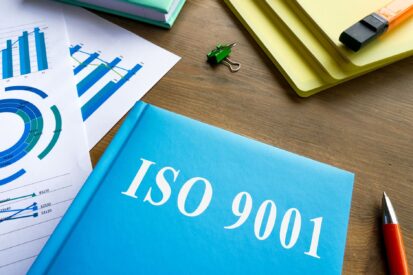In today’s fast-paced world, businesses are rapidly evolving to adapt to ever-changing market dynamics and customer expectations. While staying ahead of the competition often requires a focus on innovation and growth, attending to the foundational elements, such as information security and process quality management, is equally critical. For many organisations, achieving robust protection of information assets and demonstrating a commitment to quality management entails adhering to widely recognised international standards – specifically, ISO 27001 and ISO 9001.
At first glance, ISO 27001 and ISO 9001 may seem like separate entities, with one focusing on information security management systems (ISMS) and the other on streamlining quality management processes. However, these two standards share significant commonalities, and integrating them can offer tangible benefits by effectively addressing information security risks while streamlining quality processes and procedures. In this article, we will delve into the intricate connections between these two standards and uncover strategies for integrating them to enhance your organisation’s overall business performance.
Understanding the overlap between ISO 27001 and ISO 9001 can enable your organisation to harness the full potential of these standards as complementary tools for success. By establishing a symbiotic relationship between your organisation’s ISMS and quality management system (QMS), you can reap the benefits of an integrated approach, demonstrating your unwavering commitment to information security and quality assurance. Let us embark on this journey, decoding the synergies between these two essential management systems and unlocking success by marrying information security with quality management processes.
1. Common Threads: Understanding the Overlap Between ISO 27001 and ISO 9001
Though distinct in their primary objectives, ISO 27001 and ISO 9001 share several foundational principles that contribute to the development of comprehensive, well-structured management systems. Some of these common elements include:
– Risk-based approach: Both ISO 27001 and ISO 9001 standards advocate for a risk-based methodology, focusing on identifying, assessing, and mitigating risks that could potentially impact information security and quality management processes.
– Continuous improvement: Embracing the tenet of continuous improvement, these standards demand regular evaluation and enhancement of the management systems, fostering a culture committed to perpetual growth and development.
– Documentation: Thorough and accurate documentation of processes, policies, and procedures is critical for both standards, supporting consistent implementation and facilitating effective communication of requirements across your organisation.
2. Integrating the Management Systems: A Unified Approach to Information Security and Quality Management
Developing a seamless and cohesive strategy for integration of ISO 27001 and ISO 9001 management systems requires careful planning and assessment of organisational processes and objectives. The following steps outline the key actions for achieving this synergy:
– Conduct Gap Analysis: Evaluate your existing ISMS and QMS to identify gaps, redundancies, or inconsistencies between the two systems. This analysis provides the foundation for integration efforts, allowing you to address areas of concern and ensure alignment with the requirements of both standards.
– Develop Integrated Policies and Procedures: Create a unified set of policies and procedures outlining your organisation’s approach to information security and quality management. Establish clear objectives, and ensure that these policies align with the risk-based approach advocated by both ISO 27001 and ISO 9001 standards.
– Allocate Resources and Responsibilities: Allocate appropriate resources and designate responsibilities for the effective functioning of the integrated management system. Establish a clear reporting structure that accommodates both information security and quality management teams, fostering collaboration and communication.
– Implement Monitoring and Internal Auditing: Establish processes for ongoing monitoring and internal auditing of the integrated systems, ensuring that the requirements of both ISO 27001 and ISO 9001 are consistently met and that potential risks and inefficiencies are promptly identified and addressed.
– Document and Review: Maintain comprehensive documentation of the integrated systems, including policies, procedures, and performance metrics. Conduct regular management reviews to evaluate the effectiveness of the integrated approach and identify opportunities for continuous improvement.
3. Reaping the Benefits: How Combining ISO 27001 and ISO 9001 Enhances Business Performance
The integration of ISO 27001 and ISO 9001 management systems can unlock transformative benefits for your organisation, from cost savings to improved efficiency and strengthened security posture. Some notable advantages include:
– Streamlined Processes: Eliminating redundancies and aligning policies, procedures, and documentation across both standards can lead to streamlined processes, resulting in increased efficiency and reduced administrative burden.
– Holistic Risk Management: Combining the risk assessment processes for information security and quality management enables your organisation to adopt a comprehensive, unified approach to risk mitigation, facilitating a more resilient overall business strategy.
– Cost Savings: By implementing an integrated management system, organisations can reduce duplication of resources, lower training costs, and optimise auditing expenses.
– Enhance Reputation: Demonstrating adherence to both ISO 27001 and ISO 9001 standards can elevate your organisation’s reputation, reflecting a strong commitment to information security and quality assurance amongst customers, suppliers, and other stakeholders.
4. Sustaining Success: Continuous Improvement and Ongoing Engagement
The journey towards an integrated approach to information security and quality management does not end with the implementation of a combined system. To sustain and build upon your organisation’s success, it is essential to remain engaged with continuous improvement processes and remain responsive to evolving risks and challenges. Some strategies for maintaining a robust integrated management system include:
– Regularly review and update policies and procedures to align with changes in the market, regulatory landscape, and technological advancements.
– Seek ongoing employee feedback and involvement, ensuring that staff members are engaged with and committed to the integrated approach.
– Invest in employee training and professional development, equipping your workforce with the knowledge and skills necessary to navigate the ever-changing business environment.
Unlocking Success Through Integration of ISO 27001 and ISO 9001 Standards
By embracing the synergies between ISO 27001 and ISO 9001 standards and developing a comprehensive, integrated strategy for information security and quality management, your organisation can unleash its full potential and rise to the challenges of today’s competitive landscape. To ensure ongoing success in information security and process excellence, it is crucial to remain vigilant to the need for continuous improvement and adaptation to evolving external influences. As you forge ahead with your integrated ISMS and ISO QMS journey, our dedicated team at ISO 9001 Consultants stands ready to support your organisation with expert guidance, resources, and assistance.








Users Comments
Get a
Quote